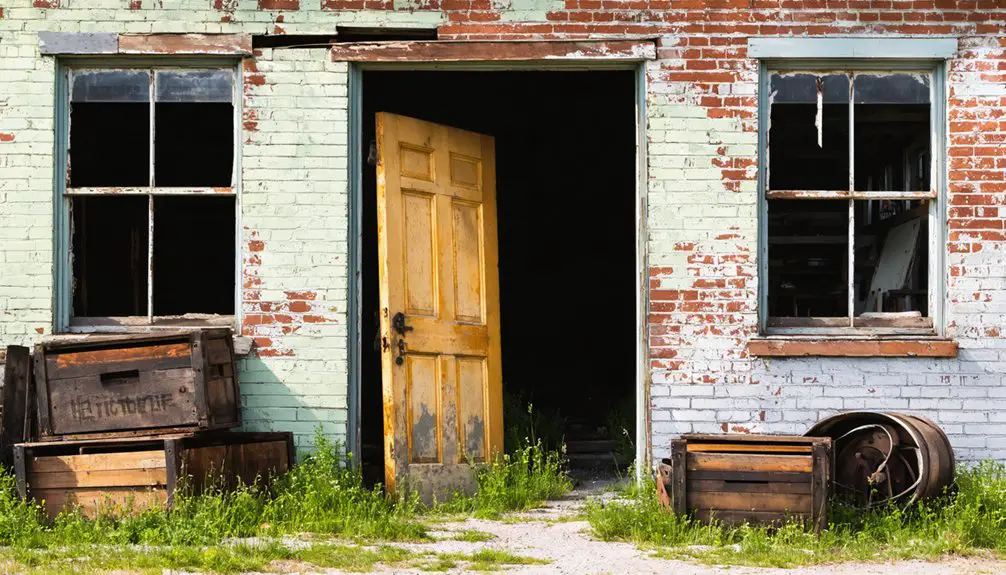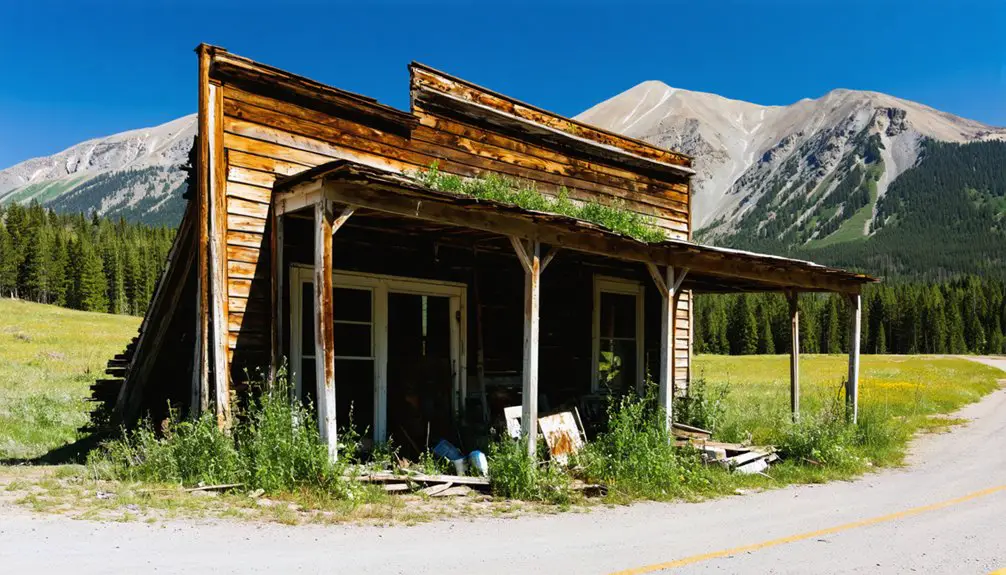You’ll discover Ruby City’s dramatic rise as a silver boomtown in Washington’s Okanogan County, where over 1,000 prospectors transformed Thomas Fuller’s lone 1885 cabin into a rowdy settlement of 700 residents by 1888. The town earned its reputation as the “Babylon of Washington Territory” through frequent shootouts and lawlessness until the 1893 silver crash devastated the local economy. Today, you can explore the stone foundations and markers that trace this once-thriving mining community’s remarkable past.
Key Takeaways
- Ruby City was a thriving silver mining town established in 1886 that grew to over 1,000 residents before becoming a ghost town.
- The town earned the nickname “Babylon of Washington Territory” due to its notorious reputation for violence and frequent gunfights.
- Ruby City’s decline began with the 1893 silver market crash, when prices dropped to $0.63 per ounce, forcing mines to close.
- The settlement once boasted 70 buildings, including saloons and stores, serving as a brief county seat during its peak.
- Today, only rock foundations and historical markers remain along Salmon Creek in Okanogan County, marking Ruby City’s former location.
The Rise of a Silver Mining Boomtown
When the Moses Indian Reservation opened for mining in 1886, prospectors quickly descended upon Ruby Mountain in Washington’s Okanogan region, launching one of the state’s most significant silver rushes.
Thomas D. Fuller’s prospector stories began a year earlier when he built the first cabin, secretly exploring the area before it officially opened.
Along with fellow miners Thomas Donan, William Milligan, and John Clonan, they discovered rich silver veins using basic mining techniques to trace mineralization at geological contacts where magma met older rocks. The mining camp grew rapidly to reach over a thousand residents by 1888.
Early prospectors traced rich silver deposits where ancient rock formations collided with magma, revealing valuable mineral veins.
Their findings led to the formal organization of the Ruby Mining District in 1887, which quickly grew into a bustling mining area with the Fourth Of July Mine becoming one of the district’s top producers.
Daily Life in Ruby’s Wild West Era
Life in Ruby City during its boomtown years revealed the stark contrasts of frontier existence, where simple frame buildings and temporary tent dwellings housed a population driven by silver dreams.
Your daily routines would’ve centered around the demanding rhythms of mining life, with 24-hour operations keeping the town alive. You’d find sustenance through local hunting, with mule deer jerky becoming a dietary staple. Travel through town meant navigating along the single rutted road that served as the main thoroughfare. At its peak, the town supported a thriving community of 700 residents.
Social customs flourished despite the harsh conditions – you could’ve joined community dances where local fiddlers played while neighbors shared jerky, cake, and coffee.
The town’s numerous saloons, like the Mother Lode and Silver Corner, offered escape from the day’s toils. When cash ran short, you’d trade with the Bank of Ruby‘s distinctive pink checks, adapting to frontier innovation born of necessity.
Economic Forces Behind Ruby’s Growth
You’ll find Ruby City’s explosive growth began with the 1886 silver discovery that triggered an influx of miners and speculators to stake claims on Ruby Mountain and Peacock Hill.
By 1888, your newly established mining district transformed from wilderness into a bustling settlement of 700 residents occupying 70 buildings, complete with essential services and the coveted county seat designation.
Much like the reddish-pink to blood-red gemstones mined in places like Myanmar and Thailand, Ruby City’s minerals captivated investors looking to strike it rich.
Your investment opportunities in Ruby expanded through local publications like the *Ruby Miner* that marketed the area’s mineral wealth, while mining syndicates poured capital into operations like First Thought and Last Chance mines.
Silver Rush Ignites Growth
The discovery of silver in 1886 on Ruby Mountain and Peacock Hill sparked an economic boom that transformed a quiet stretch of Salmon Creek into the bustling town of Ruby City.
You’d have witnessed a remarkable transformation as the mining camp rapidly evolved into a thriving settlement of 700 residents by 1888, with 70 buildings lining its main street.
This silver discovery established Ruby City as a regional powerhouse, even briefly serving as the Okanogan County seat.
The town’s mining heritage took root when rich silver deposits, formed 90 million years ago, yielded valuable ore.
Mining Claims Attract Investment
While mineral discoveries initially drew prospectors to Ruby Mountain, it was the organized staking of lucrative mining claims that transformed the area into a magnet for major investment.
You’ll find that early claim stakers like Thomas Fuller and John Clonan secured valuable ledges containing silver and gold, establishing mines like First Thought, which later produced over $2.5 million worth of silver ore in today’s dollars.
Investment strategies evolved as mining syndicates, led by prominent figures like U.S. Senator Jonathan Bourne Jr., began consolidating claims and forming corporations to fund expensive underground operations.
These business structures attracted substantial capital from Portland’s business elite, who saw opportunity in the region’s rich mineral deposits.
To process the ore locally, investors funded critical infrastructure including stamp mills and aerial tramways, though the 1893 silver market crash would ultimately derail their ambitious plans.
Boomtown Infrastructure Expands
As Ruby City’s population swelled in the early 1890s, rapid infrastructure development transformed the rugged mining camp into a functioning boomtown.
You’d have seen contractors busily grading Main Street while new business blocks and homes sprouted along the improved thoroughfares. The town’s growth demanded better connections to neighboring settlements, spurring road improvements that would support the steady flow of miners and supplies.
Local residents rallied behind infrastructure projects, raising funds for road construction and pushing for utility installations to serve the expanding population. Much like modern Othello’s efforts to secure sustainable water supply, Ruby’s development hinged on managing essential resources. The community actively documented their progress through local newspaper clippings, preserving their development story for future generations.
Though Ruby never quite matched the prosperity of nearby Salmon City (Conconully), mining profits fueled steady development throughout the early 1890s.
The town’s physical expansion reflected the community’s determination to build a permanent settlement, even as limited funds sometimes constrained their ambitious plans.
Notable Characters and Lawless Tales

As you explore Ruby City’s lawless past, you’ll encounter colorful characters like the generous but notorious cattle-rustling butcher who nearly sparked a civil uprising between miners and vigilante cattlemen.
Much like how ancient traders moved along the Silk Road in 200 BC carrying precious gemstones, Ruby City saw its own share of valuable cargo and questionable transactions pass through its streets.
When local guards transporting the accused butcher became intoxicated, the defendant made a swift escape from custody.
You’ll witness the darker side through incidents like the 1888 brothel shooting, where a madam fatally shot an intruder through the heart while the county auditor casually stepped over the body.
The town’s reputation as the “Babylon of Washington Territory” was earned through frequent shootouts and violence, though figures like county prosecutor Guy Waring attempted to maintain order by directing legal proceedings away from mob justice.
Wild West Shootouts Unfold
During the late 1880s, Ruby City earned its reputation as one of the West’s most violent silver mining towns, where gunfights erupted regularly in saloons, streets, and brothels.
You’d witness infamous shootout legends unfold as miners, gamblers, and outlaws settled scores with blazing revolvers. Sheriff Robert Allison and his posses chased armed bandits while gunfight tactics evolved from quick-draw duels to strategic ambushes. Just as in Newton, Kansas, where seven men died during the infamous Tuttles Dance Hall shootout.
In March 1888, a drunken man learned the hard way that even brothel madams packed heat when he was killed attempting to cause trouble.
While some gunfighters faced trial under “fair fight” principles, others like the mysterious “Riley” vanished into the frontier after deadly confrontations.
With limited law enforcement, you’d find residents relying on armed citizen groups and self-defense to maintain order in this silver-fueled powder keg.
Miners and Madams Collide
The raw clash between miners and madams shaped Ruby City’s wild character throughout the late 1880s.
You’d find miners’ alliances forming around figures like Thomas Fuller and Fred Wendt, who struck it rich in silver claims, while madams’ influence grew through their strategic control of entertainment and lodging near the mines.
The town’s disorder played out in frequent confrontations, where miners rallied behind their favorite madams during disputes over territory and unpaid debts.
You might’ve witnessed Guy Waring’s futile attempts to prosecute lawbreakers, while drunken guards let prisoners slip away.
The volatile mix of silver wealth, whiskey, and vice earned Ruby City its nickname as the “Babylon of Washington Territory,” where cattle-rustling miners and brothel operators created a powder keg of tension that defined the settlement’s untamed spirit.
Notorious Law Enforcers Emerge
Law enforcement in Ruby City emerged as a chaotic blend of frontier justice and vigilante authority, where notorious figures stepped into the void of formal policing.
You’ll find that emergent enforcers operated within a landscape of constant violence, illustrated by the 1888 incident where a brothel mistress fatally shot an intruder. The town’s mining boom fueled social disorder, with murders and disturbances becoming commonplace events.
Chaotic justice prevailed as county officials demonstrated casual indifference to violence, even stepping over murder scenes in brothels without investigation.
While specific names of Ruby City’s law enforcers remain scarce in historical records, their necessity arose from the town’s persistent lawlessness. The informal enforcement system struggled to contain the frequent outbreaks of violence tied to the explosive mix of mining wealth and frontier vice.
The Silver Crash and Town’s Decline

While silver prices remained strong through the early 1890s, Ruby City’s fortunes changed dramatically in 1893 when values plummeted by 30% to around $0.63 per ounce.
Ruby City’s prosperity shattered in 1893 as silver prices crashed, falling 30% to just sixty-three cents per ounce.
The economic repercussions were swift and devastating, forcing most mines to shut down despite having remaining silver deposits.
The mining abandonment that followed can be traced to four essential factors:
- The ore’s low-grade quality became unprofitable at crashed prices
- High freight costs from Ruby’s remote location ate into already thin margins
- The Panic of 1893 triggered widespread bank failures, cutting off critical capital
- The government’s removal of silver price supports destroyed market stability
You can still find traces of Ruby City’s brief glory days in the foundations and remnants that nature hasn’t fully reclaimed, silent witnesses to a boomtown’s dramatic fall.
Exploring Ruby’s Historical Remnants Today
Today, visitors exploring Ruby City will find remnants of its mining-era past scattered across the slopes of Ruby Mountain near Salmon Creek in Okanogan County, Washington.
You’ll discover rock foundations of former general stores, saloons, and hotels peeking through the encroaching pine trees and dense shrubbery. Two historical markers help you trace the original main street, which still serves as a rural road.
The site’s historical significance is preserved through interpretive signage that tells the story of Ruby’s brief reign as county seat and its mining heritage.
While preservation efforts are limited, nature’s slow reclamation has inadvertently protected many archaeological features.
As you walk among the excavation marks and stone ruins, you’ll experience a haunting reminder of the town’s bustling past amid today’s peaceful solitude.
Frequently Asked Questions
Were Any Valuable Artifacts or Treasures Ever Found in Ruby’s Ruins?
You won’t find treasure hunting successes here – among thirty-five recovered square nails and mining remnants, no valuable artifacts emerged. The site’s preservation focuses on historical structures rather than precious discoveries.
What Happened to the Original Residents After Leaving Ruby?
You’ll find Ruby’s legacy lives on through residents who scattered across Okanogan County, adapting to ranching, farming, and government work. This resident migration pattern led them to more stable neighboring communities.
Did Any Paranormal Activity Occur in Ruby During Its Ghost Town Years?
You won’t find documented ghost sightings or eerie legends from Ruby’s abandoned years. Unlike other Western ghost towns, there’s no credible evidence of paranormal activity in this former mining settlement.
How Did Ruby Compare to Other Washington Mining Towns of That Era?
You’ll find Ruby matched typical town demographics of 700-1,000 residents, but its brief county seat status and strong silver focus set it apart from Washington’s primarily gold mining settlements.
What Native American Tribes Lived in the Ruby Area Before Mining Began?
Like threads in an ancestral tapestry, you’d find the Okanogan (Syilx) people and Moses Band of Sinkiuse-Columbia wove their cultural significance through these lands, sharing tribal legends before miners arrived.
References
- https://www.youtube.com/watch?v=rsV_cHE7u1U
- https://en.wikipedia.org/wiki/Ruby
- https://revisitwa.org/waypoint/ruby/
- https://parks.wa.gov/about/news-center/field-guide-blog/old-ruby-state-park-heritage-site-history
- http://www.ghosttownsusa.com/ruby2.htm
- https://en.wikipedia.org/wiki/Ruby_Mining_District
- https://www.dnr.wa.gov/Publications/ger_ic112_iaml_ruby_hill.pdf
- http://www.ghosttownsusa.com/bttales48.htm
- https://www.legendsofamerica.com/az-ruby/
- https://archive.org/download/storyofrubyminew00unse/storyofrubyminew00unse.pdf



